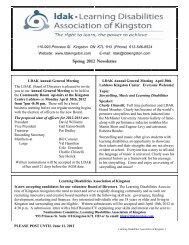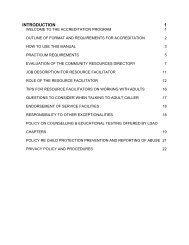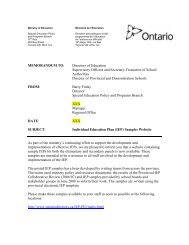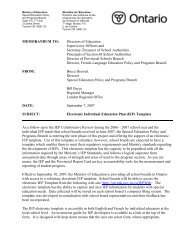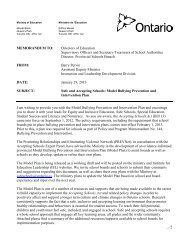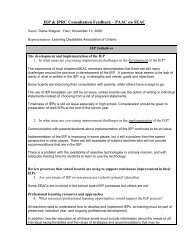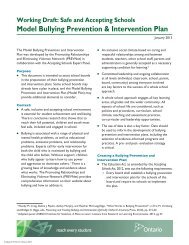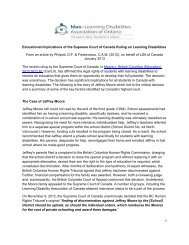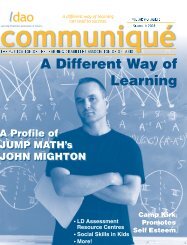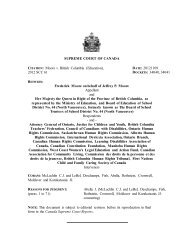LDAO Fall 2002.pdf - Learning Disabilities Association of Ontario
LDAO Fall 2002.pdf - Learning Disabilities Association of Ontario
LDAO Fall 2002.pdf - Learning Disabilities Association of Ontario
You also want an ePaper? Increase the reach of your titles
YUMPU automatically turns print PDFs into web optimized ePapers that Google loves.
ON THE LEGISLATIVE FRONT<br />
Developing a Practical and Meaningful Transition Plan<br />
for Students with <strong>Learning</strong> <strong>Disabilities</strong><br />
“If you don’t know where you<br />
are going, any road will take you<br />
there.”<br />
This quote from Alice in<br />
Wonderland describes all too well<br />
the experience <strong>of</strong> many students<br />
with learning disabilities when the time<br />
comes for them to go from one educational<br />
setting to another and, in particular, from<br />
secondary school to their post-secondary<br />
destination <strong>of</strong> choice. In spite <strong>of</strong> the fact<br />
that transition planning is a mandated<br />
process for exceptional students who are<br />
14 years <strong>of</strong> age or older and whose<br />
primary identification is any <strong>of</strong> the<br />
exceptionalities other than giftedness,<br />
research indicates that only about 10% <strong>of</strong><br />
the students with learning disabilities have<br />
a practical and meaningful transition plan<br />
included in their Individual Education<br />
Plan. This is not an acceptable level <strong>of</strong><br />
compliance with <strong>Ontario</strong>’s special<br />
education legislation. Furthermore, the<br />
lack <strong>of</strong> adequate transition planning results<br />
in students <strong>of</strong>ten making inappropriate<br />
choices for their future.<br />
Therefore, school boards must be held<br />
more accountable not only for complying<br />
with this requirement set out in Regulation<br />
181/98 and the IEP Standards Document,<br />
but also for ensuring that each student’s<br />
transition plan meets all the necessary<br />
requirements to reflect that student’s<br />
individual strengths, needs, interests and<br />
goals. Students and their parents or<br />
guardians should be able to count on this<br />
commitment.<br />
Transition is usually described as a coordinated<br />
set <strong>of</strong> activities for a student,<br />
designed to promote successful progress to<br />
and from school. Transition relates to entry<br />
into and exit from each educational level,<br />
such as pre-school to elementary school,<br />
elementary school to secondary school as<br />
well as diverse post-school activities,<br />
including post-secondary education, both<br />
university and college, vocational training<br />
including apprenticeships, employment,<br />
adult education, independent living and<br />
community participation.<br />
Successful transition for all students<br />
including those who have learning<br />
disabilities is based on the student’s:<br />
G identified needs<br />
G recognized strengths, skills and<br />
competencies<br />
G interests<br />
G preferences<br />
G short and long term goals<br />
G past experiences, including academic<br />
achievements, co-curricular and<br />
volunteer involvements at school and in<br />
the community.<br />
We know that, in order to be identified as<br />
having a learning disability, students must<br />
demonstrate that they have average to<br />
above average intelligence. Provided that<br />
they have been taught, supported and<br />
accommodated throughout their<br />
educational career appropriately, they<br />
should be able to be successful in the postsecondary<br />
destination <strong>of</strong> their choice.<br />
While intellectually most <strong>of</strong> them can<br />
handle the demands <strong>of</strong> post-secondary<br />
education, they should be encouraged to<br />
make independent choices and be<br />
supported through appropriate transition<br />
planning to achieve their personal goals.<br />
Changes which affect successful transition<br />
from secondary school to post-secondary<br />
settings for students with learning<br />
disabilities are:<br />
G direct teaching and teacher/student<br />
contact decrease significantly<br />
G academic and achievement expectations<br />
increase<br />
G changes in the available personal<br />
support network<br />
G reduced hands-on support role for<br />
parents and others<br />
G greater expectations on the student<br />
to become:<br />
G self-motivated<br />
G resilient<br />
G more independent<br />
G able to manage the many demands<br />
<strong>of</strong> more independent living and/or<br />
living with support in the<br />
community<br />
G self-advocate<br />
G able to cope with disclosure<br />
challenges<br />
G able to apply coping strategies<br />
independently<br />
G able to identify and advocate for<br />
accommodations required<br />
The primary responsibility for facilitating<br />
successful post-school transition for<br />
students with learning disabilities rests<br />
with the school board and in particular<br />
with the student’s school principal.<br />
However, parents and students must<br />
(continued on page 5)<br />
FALL 2002, PAGE 4




